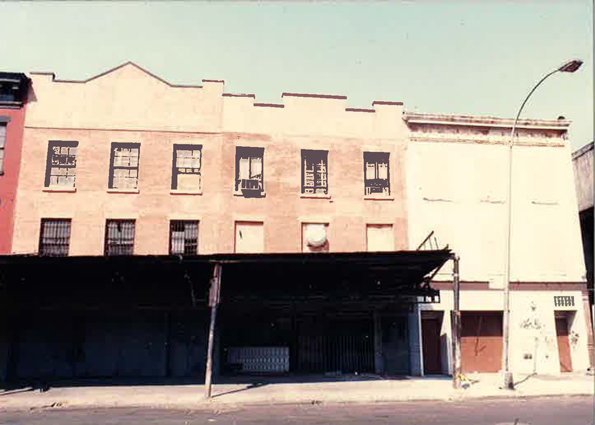Then & Now on Little West 12th Street
We’d like to share GVSHP staffer Amanda Davis’ “Then & Now” post about a delightful block just west of the High Line.
On the other side of the High Line, just outside the Gansevoort Market Historic District, sits two old three-story rowhouses at 53 and 55 Little West 12th Street. Now home to the Brass Monkey, a popular restaurant and bar, the two little buildings sit by themselves. Looming in the background is the soaring Standard Hotel, designed by the Polshek Partnership (now Ennead Architects), and built in 2009.
The contrast of these historic load-bearing brick rowhouses and the “floating” curtain-wall glass of the posh Standard Hotel speaks to the ever-changing character of this neighborhood. By going back in time a mere 25 years through the 1989 “then” photograph, we can see how this little section of the Meatpacking District has changed. I am particularly drawn to the “ghost town” quality of this photograph. Anything but abandoned, however, the district thrived not as a trendy club scene, but as a neighborhood full of vendors transporting goods in and out of warehouses.
While a good portion of the area is now protected through the landmark designation of the Gansevoort Market Historic District we successfully fought for in 2003, the buildings on Little West 12th Street featured in the “then” photograph were not included. Of the four (built in 1888), only nos. 53 and 55 remain today. Their neighbors at nos. 51 and 57, oddly enough, were the more intact of the group with their pressed metal cornices still present in 1989 (the surviving middle buildings once had similar cornices). At the time, 51-55 Little West 12th Street operated as a meat processing plant with offices and cold storage facilities; no. 57 was part of the wholesale meat market at 20 Tenth Avenue around the corner.
The surviving buildings at 53 and 55 have lost their metal canopy, and the triangular parapet of no. 55 has since been leveled. Although these parapets were not original to either building, it is likely they were added in 1930 when major alterations occurred inside each building (replacing cornices with stepped parapets was common in this era). These two little survivors have faced a lot of change over the years, but, even still, they continue to play a part in the neighborhood’s evolution. Be sure to look their way on your next walk along the High Line.
Lear more about Gansevoort Market here and GVSHP’s work in the Far West Village here.



Those of us who walked the Gansevoort Market a couple of decades ago remember the bustling commercial streets, the moving metal hooks with carcasses rotating above the sidewalks, the barrels full of guts and fat, and the unmistakable odor. (Did I mention that I’m a vegetarian?) The Greenwich Village Society for H.P. had me write a brief guide to the district (http://anthonywrobins.com/wp-content/uploads/2013/01/Gansevoort-Market-WalkingTour.pdf) in 2001 – it’s still accurate about the buildings, but the scene seems to have evolved at light speed. Notable losses: murals of cows and sheep on various surfaces. Even then, the meat market was morphing into an art market, a real-estate market, and of course a different kind of meat market….